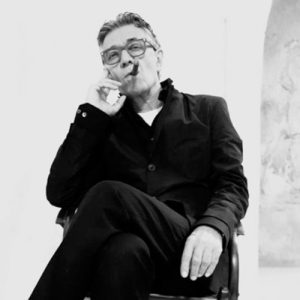
Hossein Zenderoudi is the man of measure in communication, a measure conditioned by memory, which is an essential factor in the artist’s distancing of creativity from the semantic and formal elements of his idiom. This globalizing memory is that of a continuing Shiite Islam, but also of 2500 years of Persian antiquity dominated by the reformist Zoroaster. Born in 1937 in Tehran, Zenderoudi was soon attracted by writing. Being the support of communication, writing is also the depository of sacredness, or more exactly, of its trace. In the eternal struggle between good and evil, the sacred manifests its presence by summoning us back to the two essential options, truth and justice. Art in its references to it proposes the trace of good: the trace and not the traced. This distinction is the linchpin of Zenderoudi’s intuition, forming the inner guidance that governs the whole development of his oeuvre. Arabic calligraphy offers an inexhaustible reservoir of signs, dots, letters and numbers, from which the trace of being in real life can be re-established.
Zenderoudi was still a student at the fine arts school of his home city when he laid the foundations in 1960 for a pictorial movement that was to renovate the spirit of eastern gestural writing: the Sagha Khaneh school. The school, which gets its name from the fountain-stops decorated with popular illuminations or with verses from the Koran, where passers-by can quench their thirst, gives writing the sacredness of an existential quotidian magic. A prize-winner at the Paris Biennale the following year, Zenderoudi settled in Paris in 1961. There he developed a robustly original graphic style which established itself brilliantly within the moving lyrical abstraction of the time, halfway between the free action of Informel and the signifying-signified dialectic of Lettrisme.
Zenderoudi arrived in Paris at the end of the widespread infatuation with gestural calligraphy. He was able to ascertain for himself the signifying limits of the traced in writing, and to boost his crucial intuition of graphic distance through trace. The immediate trace of the sign is its imprint: and in each period of his work the artist turned to stamping imprints. There are traces of it in the first compositions at the Sagha Khaneh school, in 1958-60, on oiled brown wrapping papers or linens, where wads represent votive padlocks. Their repetitive and accumulative composition continued throughout the ‘90s, notably in the series of cities or in that of the Virgin of Constantinople. From 1999 and in the past two years, Zenderoudi has substituted the photographic negative for the printing of signs or images. Views of Iranian landscapes emerge from wide colour fields animated by broad strokes of vibrant paint, thus bringing us to the tip of continuity in the structural weft of writing traced in Zenderoudi’s work: the fleeting evocation of reality in the pictorial flow of global communication. In 1961 the artist had kept his distance from the gestural conformity of lyrical abstraction, by developing the quantitative language technique of repetitive stamping imprints, as did Arman in early works like “Les Cachets” (1955-58). In 1999 Zenderoudi turned to another technique of quantitative language: that of the photographic transfer.
This type of transfer is of capital importance if we are to judge the present dimension of an oeuvre founded on spiritual tradition, linked to a holy scripture and thus devoted to a certain referential continuity, but dominated by an “inner guidance”: that of a necessity for global communication.
The requirement of global communication implies two objectives in the public’s reception of the message, namely semantic transmission and spiritual participation. The two keys to its interpretation are indissolubly welded in the spirit of their creator: “Men the world over are identical and can all read my work. What matters is to achieve a harmony between the person who created it and the spectator” This twofold goal sets the true measure of the creative act in Zenderoudi’s work, of the supple and adaptable climate of spiritual realism that surrounds it. That is the lesson of profound humanism drawn from his Koranic culture and from the teachings of the theologian Ostad Elahi: the soul is the object of knowledge, which implies the superseding of any dichotomy between matter and mind, rationalism and spirituality. Significantly, the artist has illustrated the Koran and illuminated Ostad Elahi’s “Traces of Truth”, which are prominent among his contributions to the bibliophily of high spirituality.
Suppleness in the transmission of his message has enabled Zenderoudi at various points in his career to cut out a cultural situation for himself and to ensure its actuality in an original and specific way. After Sagha Khaneh came the Parisian Informel and Lettrisme. Faithful to his strategy of detachment from calligraphy, Zenderoudi favours the trace as opposed to the traced, in writing. To favour the trace compared to the traced is to divert the sign in order better to appropriate it.
When Zenderoudi introduces the printed image of the Angel or of the Virgin of Constantinople into his work, he remains faithful to the demand for communication. He presents the trace of an icon within the global flow of information, and there it admirably transmits its message of transcendental spirituality. In the panorama of global culture everything has its place: be it black bryony, the Jesus label or the Coca Cola logo. A closeness to the public’s heart always occurs at the right level of each spectator’s affectivity. Zenderoudi’s spiritual realism allows him to believe in the truth and justice of communicational space: the soul is equally at ease in the dense fabric of a calligraphic weave, in the immaterial ether of a media flow, or on an evanescent and fleeting monitor screen. Yes, my dear Hossein, you have convinced me: I find the same “warmth of distance” in a canvas print in mixed medium dated 1994 as in a coloured photographic transfer of the Iranian desert in 2001. Another canvas done in 1994 was titled “Luminous Instants”. Now I await many more of these luminous instants, in the photomechanical style brought into fashion by Andy Warhol forty years ago and which you have today sealed with your own unmistakable trace of justice and truth.
You are mentioned, Hossein, as an example of East-West synthesis. Rather than confine myself to noticing its effect, I prefer to retrace an analysis of its cause, which lies in that demand for global communication, the manifestation of a fundamental intuition which made you drop the self-reductive voluntarism of a formalist trace of writing to the advantage of a supple system of traces. In assuming the distanced memory of an original language, these traces liberate its universal value. When they distance themselves from the Arabic alphabet traced, to assume the form of architectures of signs or of inner landscapes, woven fabrics of meditation, I submit to their spellbinding power and find it perfectly normal for the titles given to these works to stress their linguistic detachment. After all, never mind if there is more or less water in the glasses and so much the better if one can take tea together. I undergo in all its plenitude the visual effect of the message’s global communication.
No plenitude without saturation. Today the destiny of images in the global flow of communication is played out on the evanescence of the television screen. The trace of the electronic image conveyed by media also experiences its saturation effect: diluted in the total jamming of the screen at the end of a broadcast or programme. Don’t the “inner spaces” saturated with Zenderoudi’s signs herald the trace of another saturation of visual language – that of the small screen open onto an empty chain of programmes? What difference is there, from the point of view of the distancing of memory, between a screen saturated with electronic impulses without any informative impact, and a canvas entirely covered with the traces of signs of an anonymous writing? None at all: the two effects of saturation belong within the same operational logic as the demand for global communication. And it is to that logic that Zenderoudi responds instinctively when he switches from the italic sign to the image, and also when he incorporates the printed or photographic trace on canvas or paper depicting the space of that informative impact of the artist’s global message.
Hossein Zenderoudi is the bearer of a precious gift: a fundamental intuition that drove him straight away in his art to speak of just and true things by their trace and to create an effect of detachment in the artist’s and in the public’s memory. What is the exact proportion of East and West in this major option and its spectacular virtue of enchantment? It matters little, it is the mystery of God’s talent and finger.
It is in any case upon this concept of distanced memory that the entire philosophy of media information and its supreme end-purpose, global communication, rests today. Distance brings the media public closer to the depth of a conceptual field indispensable to the global perception of the message addressed to it, whatever its semantic density may be.
Hossein Zenderoudi thus finds himself quite naturally in the midst of the most topical issue affecting the globalizing world of information. His work provides the establishment of a planetary ascendancy by electronic media with a universalist reference and individual answer. At this early point in the third millennium of the Christian era, this Iranian citizen of the world without frontiers of spiritual thought and of media information, seems to me more than ever like the man of true and just measure in communication.




 Argoon Art | Sell online in the simplest way possible
Argoon Art | Sell online in the simplest way possible







